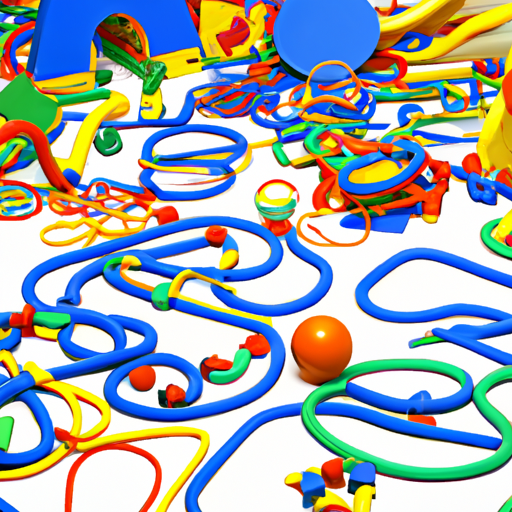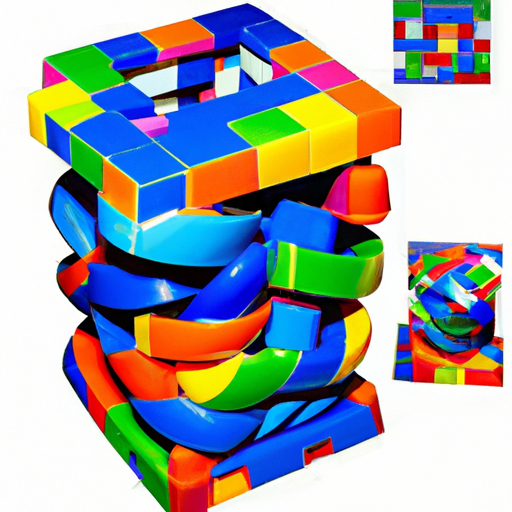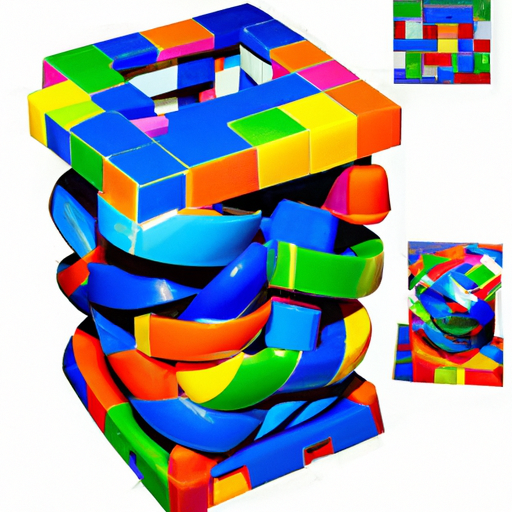You’ve probably seen them in toy stores or at children’s parties – colorful maze toys that challenge kids to navigate small balls through twisty paths. But do these toys actually improve hand-eye coordination in children? In this article, we’ll explore the research behind maze toys and their impact on developing crucial motor skills. From studies conducted by child development experts to the opinions of parents and educators, we’ll examine the evidence to determine whether maze toys are indeed beneficial for enhancing hand-eye coordination.

What is hand-eye coordination?
Hand-eye coordination refers to the ability to use visual information to guide the movements of our hands and fingers in a coordinated manner. It involves the complex interaction between our eyes and our hands, allowing us to perform tasks that require simultaneous visual processing and motor skills. Essentially, it is the connection between what we see and how we use our hands to respond to it.
Definition
Hand-eye coordination can be defined as the skill that enables us to coordinate our visual input with our motor output. It involves the coordination of sensory information from our eyes with motor commands from our brain to execute precise movements.
Importance in daily activities
Hand-eye coordination plays a crucial role in our daily activities. From simple tasks like buttoning a shirt or pouring a drink, to more complex activities like driving a car or playing a musical instrument, hand-eye coordination is essential. It allows us to perform tasks accurately, efficiently, and with ease. Without proper hand-eye coordination, even the simplest tasks can become challenging and frustrating.
Understanding maze toys
Definition of maze toys
Maze toys are interactive playthings that consist of a three-dimensional maze, usually enclosed within a transparent plastic or glass cover. The objective of these toys is to navigate a small object, such as a marble or a ball, through the maze by tilting or rotating the toy. This requires precise hand movements and visual tracking to guide the object through the maze’s twists, turns, and obstacles.
Types of maze toys
Maze toys come in various forms and designs, catering to different age groups and skill levels. Some common types of maze toys include handheld labyrinth puzzles, wooden or plastic maze balls, and electronic maze games. Each type offers a unique challenge and engages different aspects of hand-eye coordination.
Benefits of maze toys
Development of fine motor skills
Playing with maze toys can significantly contribute to the development of fine motor skills. Fine motor skills involve the use of small muscle groups, particularly those in the hands and fingers, to manipulate objects and perform precise movements. The intricate and precise control required to navigate the small object through the maze helps strengthen and refine these muscles, leading to improved dexterity and coordination.
Improvement in spatial awareness
Maze toys also aid in the improvement of spatial awareness. Spatial awareness refers to the understanding and perception of objects in relation to oneself and the surrounding environment. By maneuvering the object through the maze, children develop a better sense of space, distance, and orientation. This enhanced spatial awareness translates into improved hand-eye coordination as they learn to make accurate judgments and movements based on visual cues.
Enhancement of problem-solving skills
Engaging with maze toys promotes the development of problem-solving skills. As children navigate through the maze, they encounter various obstacles and challenges that require strategic thinking and planning. They learn to anticipate and plan their movements, analyze different routes, and make quick decisions based on visual feedback. This process of problem-solving stimulates cognitive development and fosters critical thinking skills, which are essential for success in various aspects of life.
Research on hand-eye coordination
Studies on the relationship between maze toys and hand-eye coordination
Several studies have explored the relationship between maze toys and hand-eye coordination. These studies often involve participants of different age groups, from preschoolers to adults, and examine the effects of maze toy play on various aspects of hand-eye coordination.
Results and findings
The research consistently demonstrates the positive impact of maze toys on hand-eye coordination. Participants who regularly engaged in maze toy play showed significant improvements in their ability to visually track and manipulate objects. They exhibited enhanced hand-eye synchronization and precision, as well as improved spatial perception and problem-solving skills.

Factors affecting hand-eye coordination
Age
Age is a significant factor that influences hand-eye coordination. Infants and young children are still developing their motor skills and coordination, so their hand-eye coordination abilities may not be as advanced as those of older children or adults. However, with practice and exposure to activities like playing with maze toys, hand-eye coordination can be gradually refined and improved regardless of age.
Genetics
Genetics also play a role in hand-eye coordination. Some individuals may have a natural predisposition for greater hand-eye coordination, while others may require more effort and practice to develop these skills. However, it is important to note that irrespective of genetic factors, hand-eye coordination can always be enhanced with the right tools and activities.
Physical activity level
Physical activity level is another factor that can impact hand-eye coordination. Regular physical activity, including activities that require hand-eye coordination, can help improve overall coordination skills. On the other hand, a sedentary lifestyle with minimal physical activity may hinder the development and refinement of hand-eye coordination.
How do maze toys enhance hand-eye coordination?
Visual tracking and coordination
Maze toys require precise visual tracking skills to navigate the object through the maze. The player must constantly keep their eyes on the object and anticipate its movements to make timely adjustments. This process strengthens the connection between visual input and hand movements, improving overall hand-eye coordination.
Precision and accuracy
Playing with maze toys demands precise hand movements to manipulate the object through tight corners and intricate pathways. The player must carefully control their motor actions to avoid obstacles and find the correct route. Continuous practice with maze toys helps refine fine motor skills, leading to greater precision and accuracy in hand-eye coordination.
Hand-eye synchronization
Maze toys necessitate the synchronization of hand movements with visual information. The player must react to visual cues, adjusting their hand movements accordingly to navigate the object through the maze. Practicing this synchronization repeatedly enhances the connection between the visual and motor centers of the brain, resulting in improved hand-eye coordination.
Choosing the right maze toy
Age appropriateness
When selecting a maze toy, it is essential to consider the age appropriateness of the toy. Different maze toys are designed to cater to specific age groups, and choosing the appropriate one ensures that it aligns with the child’s developmental stage and abilities. This ensures optimal engagement, safety, and skill enhancement.
Complexity and difficulty level
The complexity and difficulty level of maze toys vary greatly. It is crucial to choose a maze toy that provides an appropriate challenge for the child’s current skill level. Starting with simpler mazes and gradually progressing to more complex ones allows for continuous skill development and growth.
Variety of maze designs
Maze toys come in a wide range of designs, each offering different types of challenges and learning opportunities. Choosing a maze toy with a variety of maze designs allows for diversity in play and promotes the development of flexible problem-solving skills. Different maze designs offer unique spatial arrangements and obstacles, keeping the play experience engaging and stimulating.
Other factors to consider
Safety concerns
When engaging with maze toys, safety is of utmost importance. Ensure that the chosen maze toy has no small parts that can be a choking hazard for young children. Additionally, check that the maze toy is made of non-toxic materials and complies with safety standards.
Supervision and guidance
While maze toys are generally safe to play with, younger children may require supervision and guidance to ensure safe and appropriate play. Parental or adult involvement can also enhance the learning experience by providing support, encouragement, and guidance when faced with challenges.
Balance with other developmental activities
While maze toys offer numerous benefits for hand-eye coordination, it is essential to balance their use with other developmental activities. Variety is key in promoting holistic development, so incorporate a mix of physical, social, and cognitive activities alongside maze toy play. This ensures a well-rounded development of various skills and abilities.
Tips for enhancing hand-eye coordination with maze toys
Regular practice
Consistent and regular practice with maze toys is crucial for maximizing the benefits of hand-eye coordination development. Incorporate maze toy play into daily routines, allocating dedicated time for focused play. Consistency allows for skill retention and ongoing improvement.
Progressive difficulty levels
As skills improve, gradually introduce maze toys with higher difficulty levels. This provides new challenges to overcome, promoting continued skill development. Incrementally increasing the difficulty level keeps the play experience engaging and ensures continuous progress.
Engaging in cooperative play
Encourage cooperative play with maze toys by involving friends, siblings, or family members. Cooperative play not only fosters social skills but also challenges children to work together, communicate effectively, and strategize collaboratively. This cooperative aspect adds an extra layer of complexity to maze toy play and further enhances hand-eye coordination.
Conclusion
In conclusion, maze toys are valuable tools in enhancing hand-eye coordination. Through the development of fine motor skills, improvement in spatial awareness, and enhancement of problem-solving abilities, maze toys contribute significantly to the overall development of a child. Through research and studies, it has been established that regular play with maze toys leads to improved visual tracking, precision, and hand-eye synchronization. By considering factors such as age appropriateness, complexity, and safety, parents and caregivers can choose the right maze toy for their child. Incorporating maze toy play into daily routines, along with regular practice at progressive difficulty levels, allows for continued growth in hand-eye coordination skills. So, let the joy of navigating through mazes begin, and watch as your child’s hand-eye coordination thrives!

